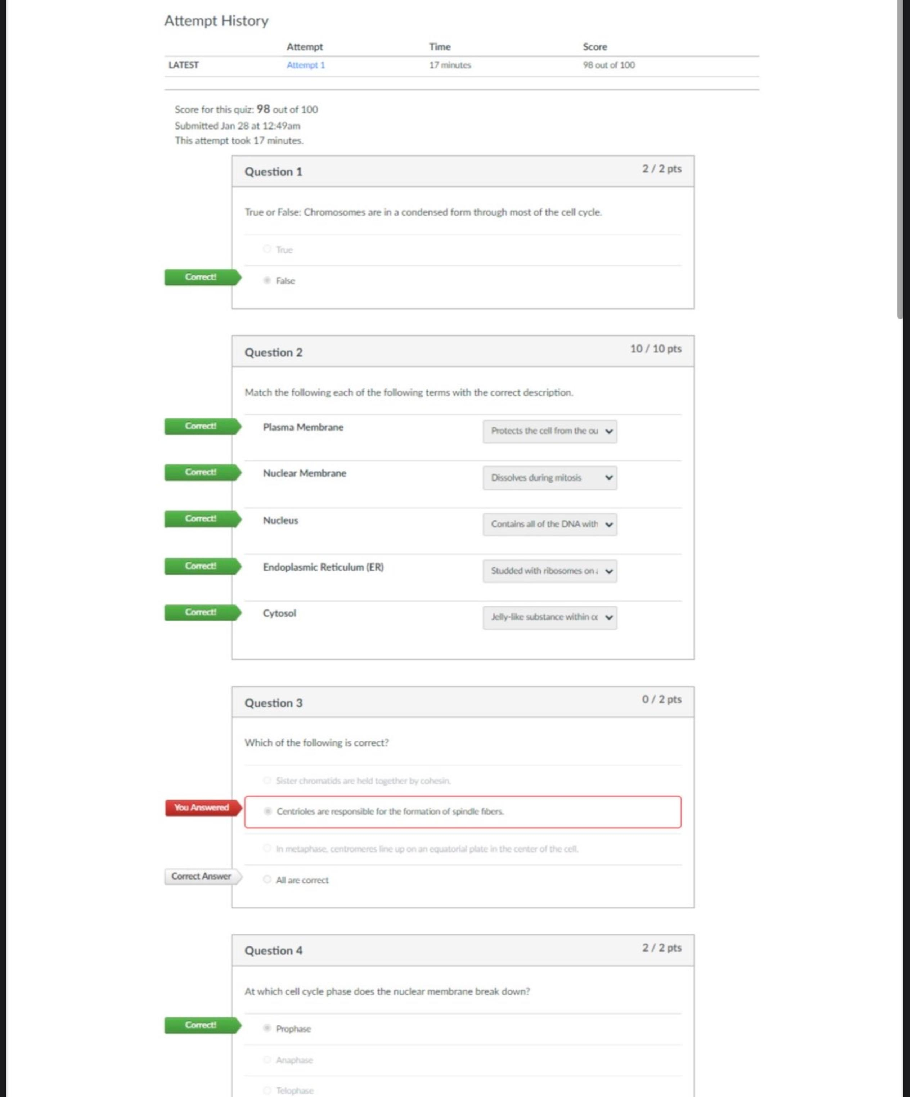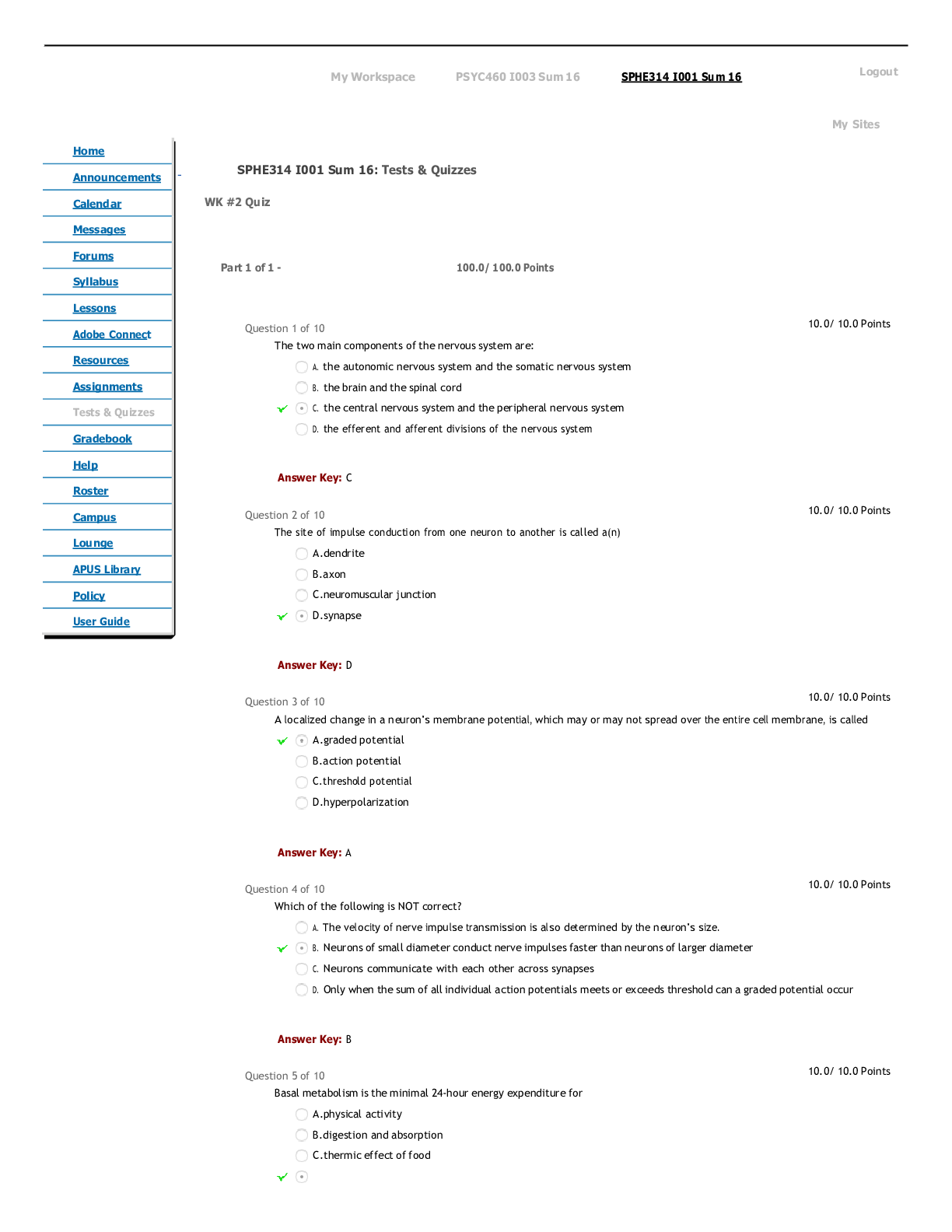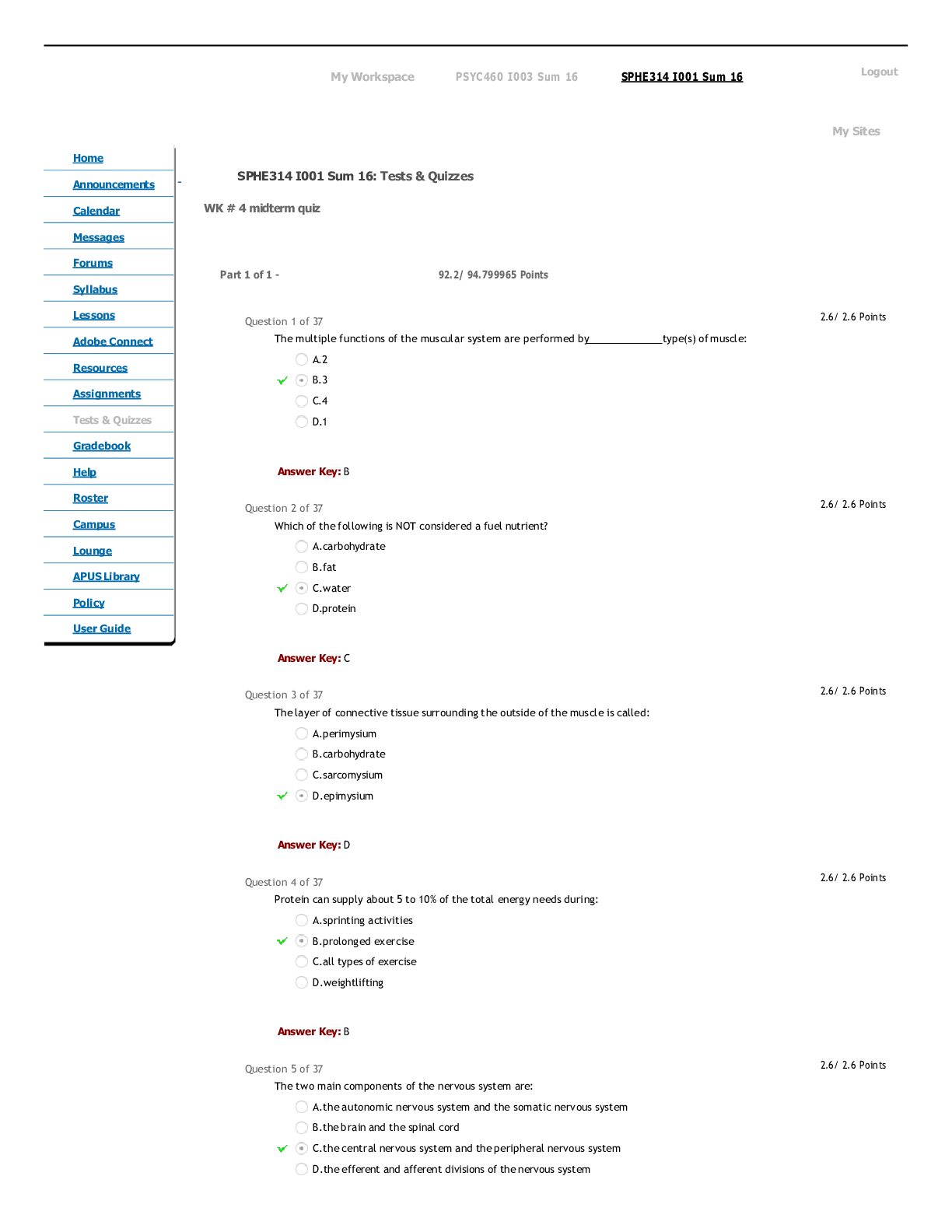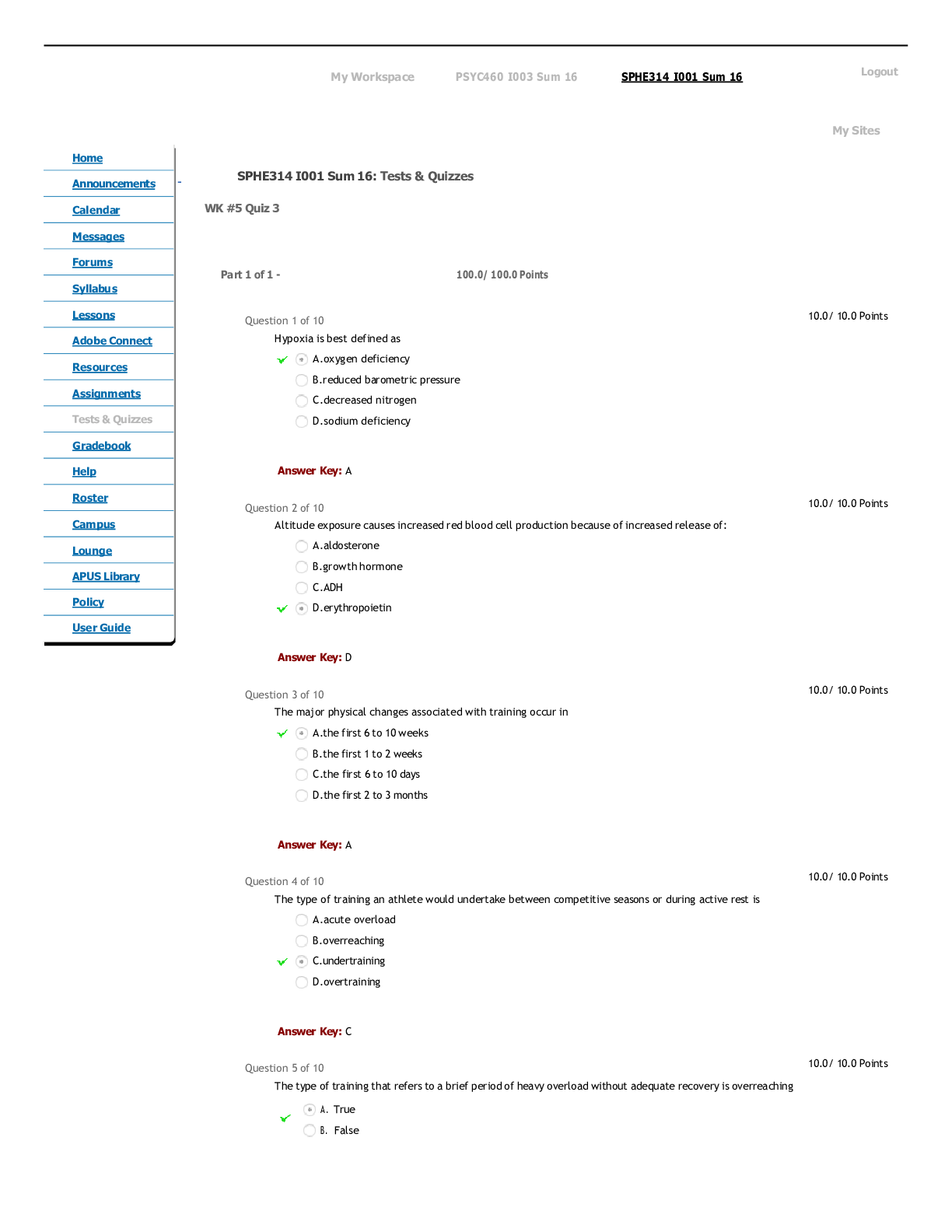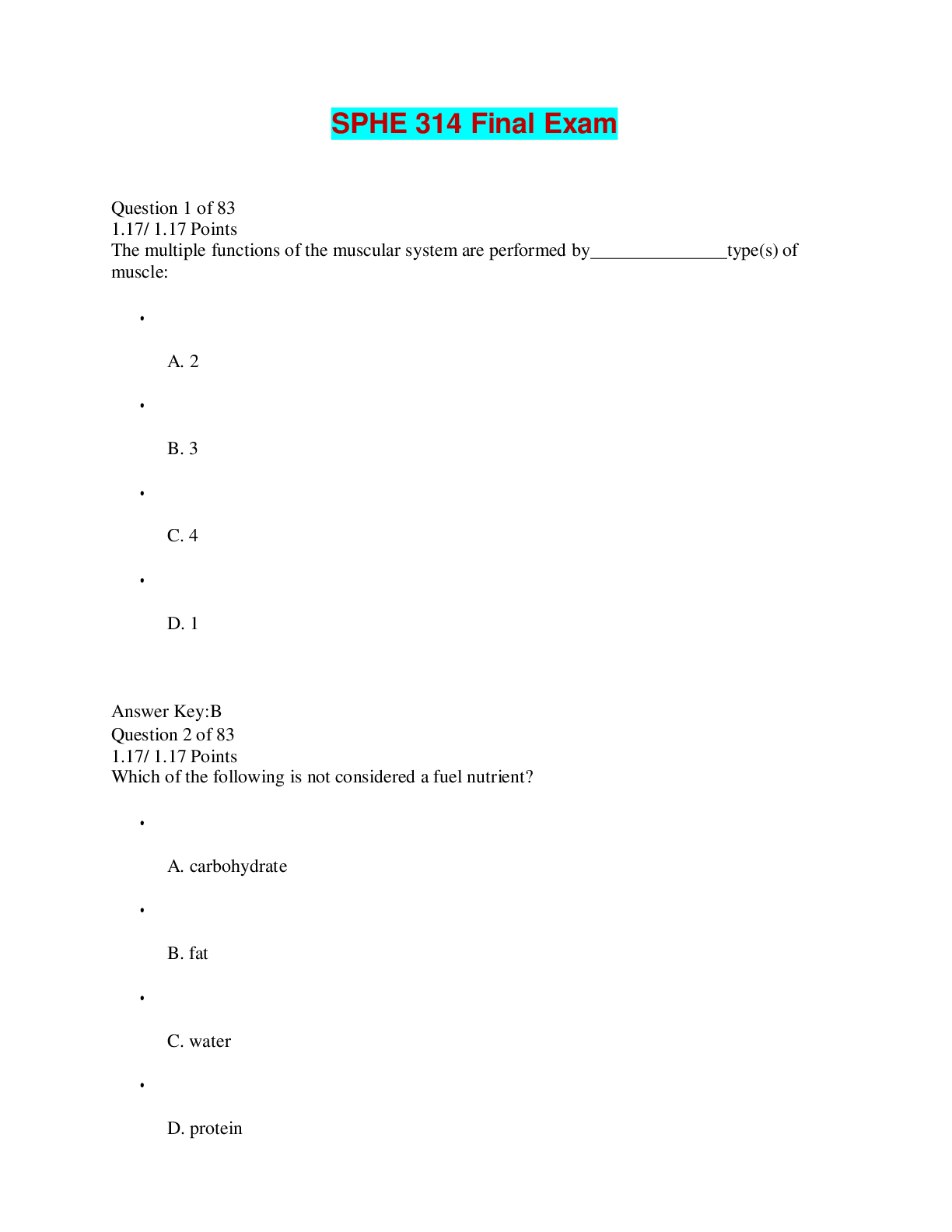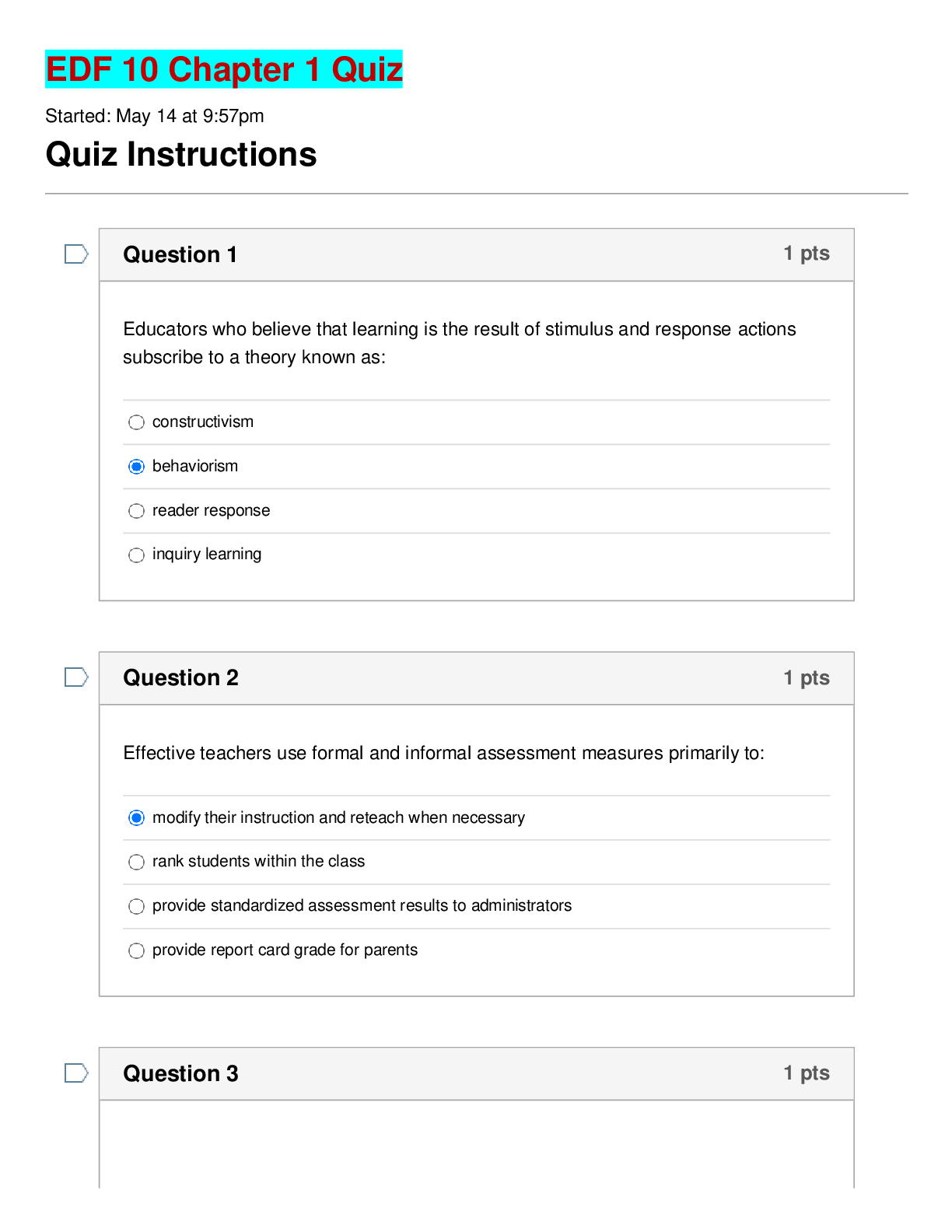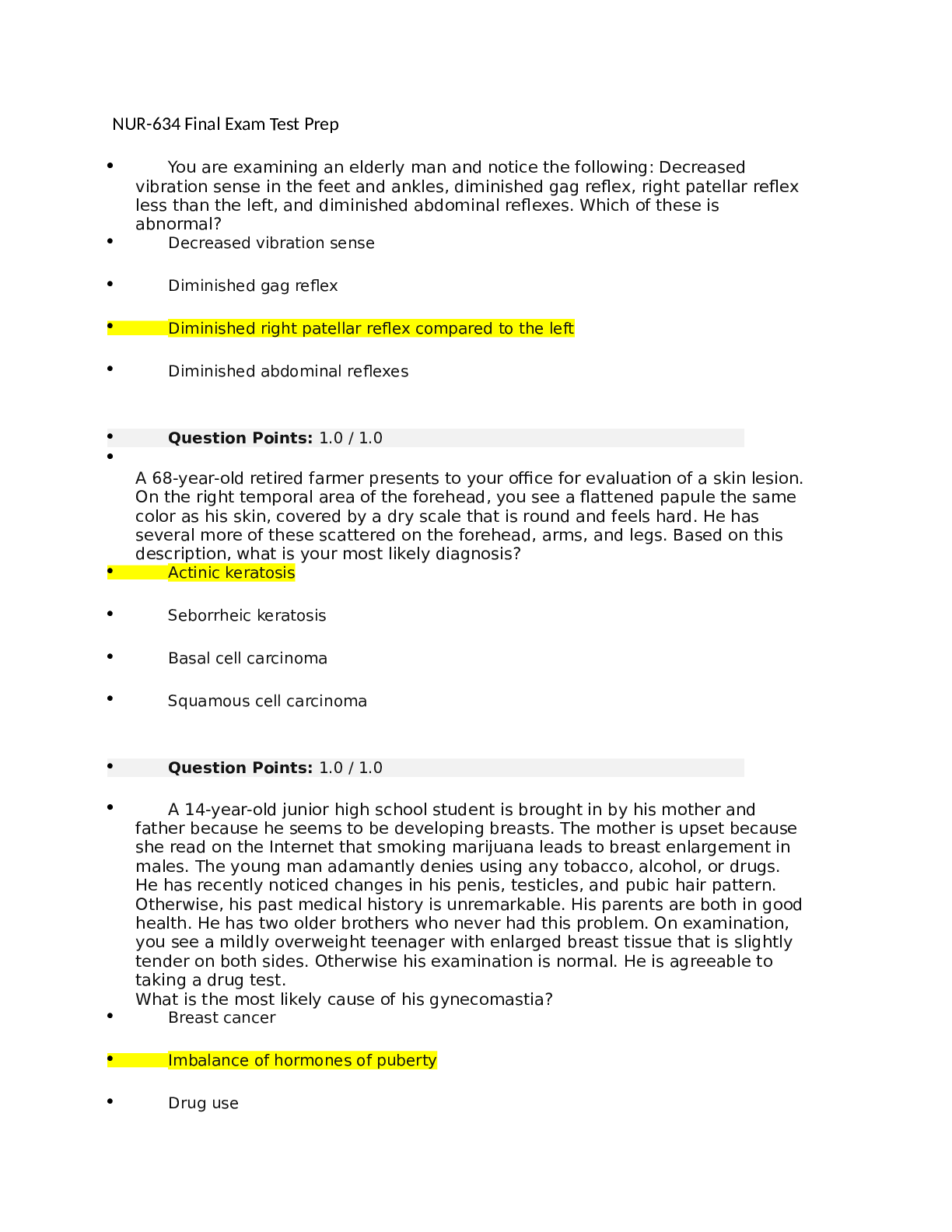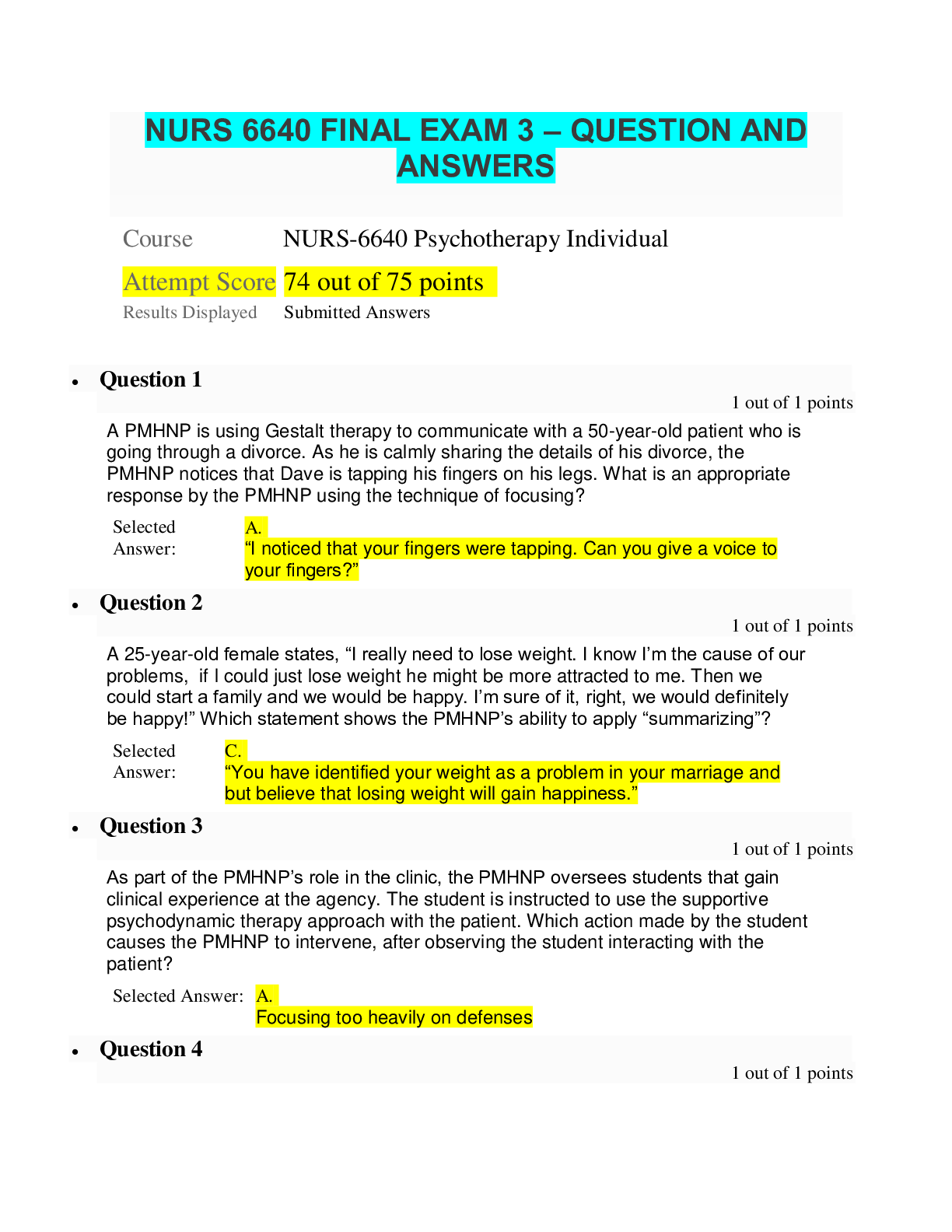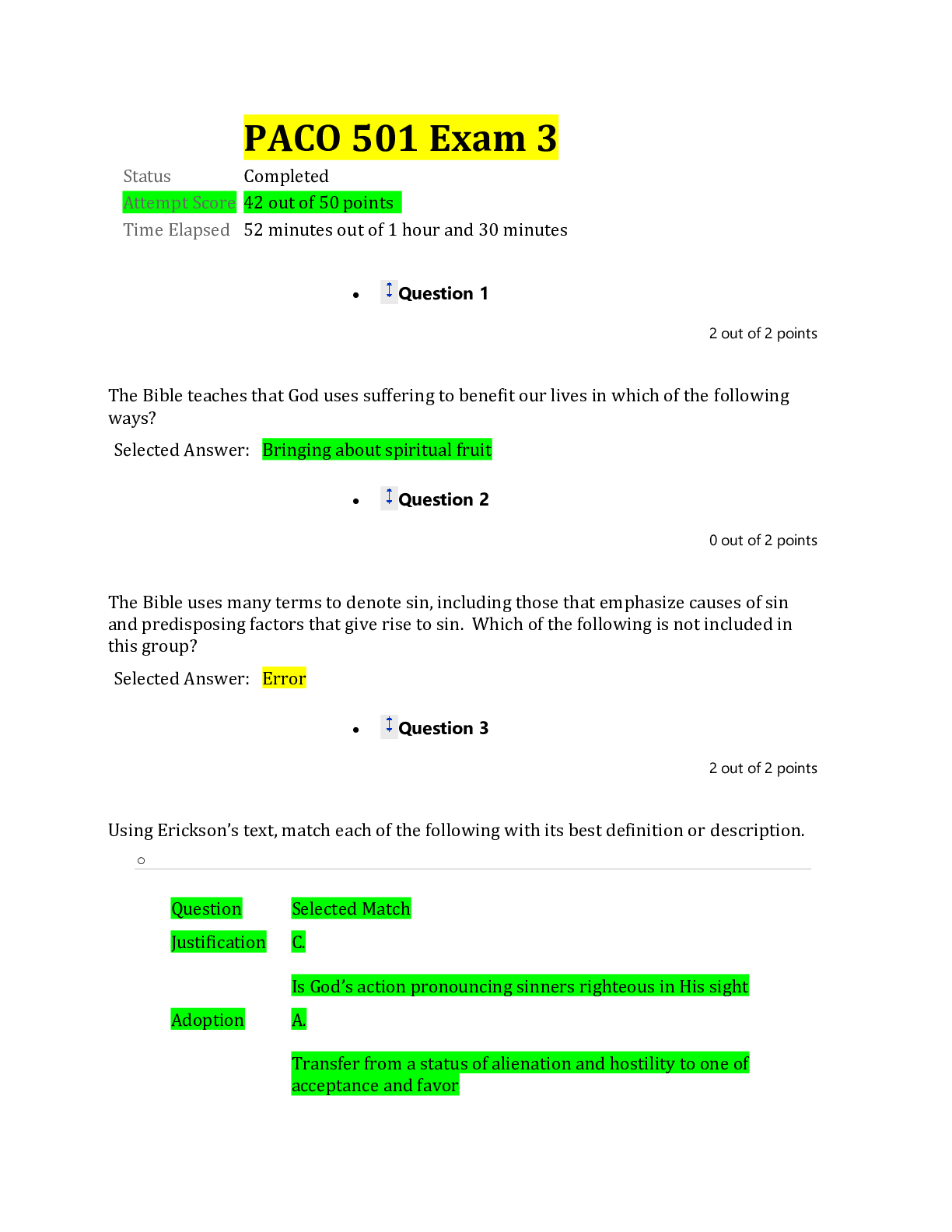NUR 417 Exam 3 | Answered with Rationales (Complete Solutions)
Document Content and Description Below
NUR 417 Exam 3 | Answered with Rationales (Complete Solutions) The nurse is doing the primary survey of an adult who was in a motor vehicle collision. After the nurse determines that the patient ha... s an unobstructed airway, which action would the nurse take next? 1. Palpate extremities for bilateral pulses. 2. Observe the patient's respiratory effort. 3. Check the patient's level of consciousness. 4. Examine the patient for external bleeding. Even with a patent airway, patients can have other problems that compromise ventilation, so the next action is to assess the patient's breathing. the other actions are also part of the initial survey, but assessment of breathing should be done immediately after assessing for airway patency. During the primary survey of a patient with severe leg trauma, the nurse observes that the patient's left pedal and posterior tibial pulses are absent, and the entire leg is swollen. Which action will the nurse take next? 1. Send blood to the lab for a complete blood count. 2. Assess further for a cause of the decreased circulation. 3. Finish the airway, breathing, circulation, disability survey. 4. Start normal saline fluid infusion with two large-bore IV lines. The assessment data indicate that the patient may have arterial trauma and hemorrhage. When a life-threatening injury is found during the primary survey, the nurse should immediately start interventions before proceeding with the survey. Although sending off blood for a complete blood count is indicated, administration of IV fluids should be started first. Completion of the primary survey and further assessment should be completed after the IV fluids are initiated. A patient who had a cardiac arrest has been resuscitated and therapeutic hypothermia is prescribed. Which action will the nurse include in the plan of care? 1. Hold the prescribed sedative drugs. 2. Check mental status every 15 minutes. 3. Initiate protocol for temperature management. 4. Rewarm if temperature is below 91 F (32.8 C). Therapeutic hypothermia, also called targeted temperature management (TTM), uses external cooling devices or cold normal saline infusions to rapidly lower body temperature to 89.6 to 93.2 F (32 to 34 C). Because hypothermia will decrease brain activity, assessing mental status every 15 minutes is not done at this stage. Sedative drugs are given during therapeutic hypothermia. A patient who is unconscious after a fall from a ladder is transported to the emergency department by emergency medical personnel. Which action would the nurse complete during the primary survey of the patient? 1. Obtain a complete set of vital signs. 2. Check a Glasgow Coma Scale score. 3. Attach an electrocardiogram monitor. 4. Ask about chronic medical conditions. The Glasgow Coma Scale is included when assessing for disability during the primary survey. the other information is part of the secondary survey. A 19-yr-old patient presents to the emergency department (ED) with multiple lacerations and tissue avulsion of the left hand. The patient denies having any previous vaccinations. What would the nurse anticipate administering? 1. Tetanus immunoglobulin (TIG) only 2. TIG and tetanus-diphtheria toxoid (Td) 3. Tetanus-diphtheria toxoid and pertussis vaccine (Tdap) only 4. TIG and tetanus-diphtheria toxoid and pertussis vaccine (Tdap) For an adult with no previous tetanus immunizations, TIG and Tdap are recommended. the other immunizations are not sufficient for this patient. A patient who experienced blunt abdominal trauma during a motor vehicle collision reports increasing abdominal pain. For which procedure would the nurse expect to prepare the patient? 1. Peritoneal lavage 2. Abdominal ultrasonography 3. Nasogastric (NG) tube placement 4. Magnetic resonance imaging (MRI) For patients who are at risk for intraabdominal bleeding, focused abdominal ultrasonography is the preferred method to assess for intraperitoneal bleeding. An MRI or CT scan would not be used unless retroperitoneal bleeding is suspected, Peritoneal lavage is an alternative, but it is more invasive. An NG tube would not be helpful in the diagnosis of intraabdominal bleeding. A patient with hypotension and an elevated temperature after working outside on a hot day is treated in the emergency department (ED). Which patient statement indicates to the nurse that discharge teaching has been effective? 1. "I'll take salt tablets when I work outdoors in the summer." 2. "I should take acetaminophen (Tylenol) if I start to feel too warm." 3. "I need to drink extra fluids when working outside in hot weather." 4. "I'll move to a cool environment if I notice that I'm feeling confused." Water and oral electrolyte replacement solutions such as sports drinks help replace fluid and electrolytes lost when exercising in hot weather. Salt tablets are not recommended because of the risks of gastric irritation and hypernatremia. Antipyretic drugs are not effective in lowering body temperature elevations caused by excessive exposure to heat. A patient who is confused is likely to have more severe hyperthermia and will be unable to remember to take appropriate action. A 22-yr-old patient who experienced a drowning accident in a local pool, but now is awake and breathing spontaneously, is admitted for observation. Which assessment will be most important for the nurse to take during the observation period? 1. Assess heart sounds. 2. Palpate peripheral pulses. 3. Check mental orientation. 4. Auscultate breath sounds. Because pulmonary edema is a common complication after drowning, the nurse should assess the breath sounds frequently. the other information also will be obtained by the nurse, but it is not as pertinent to the patient's risks for complications. The emergency department (ED) nurse is requested to plan for a response to the potential use of smallpox as a biological weapon. Which resource would the nurse recommend be obtained? 1. Vaccine 2. Atropine 3. Antibiotics 4. Whole blood Smallpox infection can be prevented or ameliorated by the administration of vaccine given rapidly after exposure. the other interventions would be helpful for other agents of terrorism but not for smallpox. Which finding indicates that the nurse should discontinue active rewarming of a patient admitted with hypothermia? 1. The patient begins to shiver. 2. The BP decreases to 86/42 mm Hg. 3. The patient develops atrial fibrillation. 4. The core temperature is 94 F (34.4 C). The nurse would discontinue active rewarming once the patient's core temperature reaches 90 to 95 F (32.2 to 35 C). Dysrhythmias, hypotension, and shivering may occur during rewarming, and should be treated but are not an indication to stop rewarming the patient. When assessing an older patient admitted to the emergency department (ED) with a broken arm and facial bruises, the nurse observes several additional bruises in various stages of healing. Which statement or question would the nurse provide first? 1. "You should not go home." 2. "Do you feel safe at home?" 3. "Would you like to see a social worker?" 4. "I need to report my concerns to the police." The nurse's initial response should be to further assess the patient's situation. Telling the patient not to return home may be an option once further assessment is done. A social worker or police report may be appropriate once further assessment is completed. A patient arrives in the emergency department (ED) several hours after taking "25 to 30" acetaminophen (Tylenol) tablets. Which action will the nurse plan to take? 1. Administer N-acetylcysteine. 2. Prepare for chelation therapy. 3. Start oxygen using a non-rebreather mask. 4. Have the patient drink large amounts of water. N-acetylcysteine is the recommended treatment to prevent liver damage after acetaminophen overdose. the other actions might be used for other types of poisoning, but they will not be appropriate for a patient with acetaminophen poisoning. A triage nurse in a busy emergency department (ED) assesses a patient who reports 7/10 abdominal pain and states, "I had a temperature of 103.9 F (39.9 C) at home." Which action would the nurse take first? 1. Administer acetaminophen (Tylenol). 2. Assess the patient's current vital signs. 3. Ask the patient to provide a clean-catch urine for urinalysis. 4. Tell the patient that it may be 2 hours before seeing a health care provider. The patient's pain and statement about an elevated temperature indicate that the nurse should obtain vital signs before deciding how rapidly the health care provider should see the patient. A urinalysis may be appropriate, but this would be done after the vital signs are taken. the nurse will not give acetaminophen before confirming a current temperature elevation. The emergency department (ED) triage nurse is assessing four victims involved in a motor vehicle collision. Which patient requires the most immediate treatment? 1. A patient with no pedal pulses 2. A patient with an open femur fracture 3. A patient with paradoxical chest motion 4. A patient with bleeding facial lacerations Most immediate deaths from trauma occur because of problems with ventilation, so the patient with paradoxical chest movements should be treated first. Face and head fractures can obstruct the airway, but the patient with facial injuries only has lacerations. Patients with femur fractures or loss of pedal pulses also need rapid intervention but do not have airway or breathing problems. The following interventions are part of the emergency department (ED) protocol for a patient who has been admitted with multiple bee stings to the hands. Which action would the nurse take first? 1. Apply ice packs to both hands. 2. Attempt to remove the patient's rings. 3. Apply calamine lotion to itching areas. 4. Give prescribed diphenhydramine (Benadryl). The patient's rings should be removed first because it might not be possible to remove them if swelling develops. the other actions should also be implemented as rapidly as possible after the nurse has removed the jewelry. Gastric lavage and administration of activated charcoal are prescribed for an unconscious patient who has been admitted to the emergency department (ED) after ingesting 30 lorazepam (Ativan) tablets. Which prescribed action would the nurse plan to take first? 1. Insert a large-bore orogastric tube. 2. Assist with endotracheal intubation. 3. Prepare a 60-mL syringe with saline. 4. Give first dose of activated charcoal. In an unresponsive patient, endotracheal intubation is done before gastric lavage and activated charcoal administration to prevent aspiration. the other actions will be implemented after intubation. A patient arrives in the emergency department (ED) after topical exposure to powdered lime at work. Which action would the nurse take first? 1. Obtain the patient's vital signs. 2. Obtain a baseline complete blood count. 3. Brush visible powder from the skin and clothing. 4. Decontaminate the patient by showering with water. The initial action would be to protect staff members and decrease the patient's exposure to the toxin by decontamination. Patients exposed to powdered lime should not be showered; instead, any and all visible powder should be brushed off. the other actions can be done after the decontamination is completed. An unresponsive 79-yr-old patient is admitted to the emergency department (ED) during a summer heat wave. the patient's core temperature is 105.4 F (40.8 C), blood pressure (BP) is 88/50 mm Hg, and pulse is 112 beats/min. Which action would the nurse plan to take? 1. Apply wet sheets and a fan to the patient. 2. Provide O2 at 2 L/min with a nasal cannula. 3. Start lactated Ringer's solution at 1000 mL/hr. 4. Give acetaminophen (Tylenol) rectal suppository. The priority intervention is to cool the patient. Antipyretics are not effective in decreasing temperature in heat stroke and 100% O2 would be given, which requires a high flow rate through a non-rebreather mask. An older patient would be at risk for developing complications such as pulmonary edema if given fluids at 1000 mL/hr. An unresponsive patient is admitted to the emergency department (ED) after falling through the ice while ice skating. Which assessment will the nurse obtain first? 1. Pulse 2. Heart rhythm 3. Breath sounds 4. Body temperature The priority assessment in an unresponsive patient relates to CAB (circulation, airway, breathing) so a pulse check should be performed first. While assessing the pulse, the nurse should look for signs of breathing. the other data will also be collected rapidly but are not as essential as determining if there is a pulse. Following an earthquake, patients are triaged by emergency medical personnel and transported to the emergency department (ED). Which color tag indicates that the nurse need to assess that patient first? a. Red b. Blue c. Black d. Yellow The red tag indicates a patient with a life-threatening injury requiring rapid treatment. the other tags indicate patients with less urgent injuries or those who are likely to die. Family members are in the patient's room when the patient has a cardiac arrest and the staff start resuscitation measures. Which action would the nurse take first? 1. Keep the family in the room and assign a staff member to explain the care given and answer questions. 2. Ask the family to wait outside the patient's room with a staff member to provide emotional support. 3. Ask the family members whether they would prefer to remain in the patient's room or wait outside the room. 4. Tell the family members that patients are comforted by having family members present during resuscitation efforts. Although many family members and patients report benefits from family presence during resuscitation efforts, the nurse's initial action would be to determine the preference of these family members. the other actions may be appropriate, but this will depend on what is learned when assessing family preferences. A patient who has deep human bite wounds on the left hand is being treated in the urgent care center. Which action will the nurse plan to take? 1. Prepare to administer rabies immune globulin. 2. Assist the health care provider with suturing the wounds. 3. Teach the patient about the use of prophylactic antibiotics. 4. Keep the wounds dry until the health care provider can assess them. Because human bites of the hand frequently become infected, prophylactic antibiotics are usually prescribed to prevent infection. To minimize infection, deep bite wounds on the extremities are left open. Rabies immune globulin might be used after an animal bite. Initial treatment of bite wounds includes copious irrigation to help clean out contaminants and microorganisms. The urgent care center protocol for tick bites includes the following actions. Which action will the nurse take first when caring for a patient with a tick bite? 1. Use tweezers to remove any remaining ticks. 2. Check the vital signs, including temperature. 3. Give doxycycline (Vibramycin) 100 mg orally. 4. Obtain information about recent outdoor activities. Because neurotoxic venom is released as long as the tick is attached to the patient, the initial action would be to remove any ticks using tweezers or forceps. the other actions are also appropriate, but the priority is to minimize venom release. Which interventions will the nurse plan for a comatose patient who will have targeted temperature management/therapeutic hypothermia? (Select all that apply.) 1. Assist with endotracheal intubation. 2. Insert an indwelling urinary catheter. 3. Begin continuous cardiac monitoring. 4. Prepare to give sympathomimetic drugs. 5. Obtain a prescription for patient restraints. Cooling can produce dysrhythmias, so the patient's heart rhythm would be continuously monitored, and dysrhythmias treated if necessary. Bladder catheterization and endotracheal intubation are needed during cooling. Sympathomimetic drugs tend to stimulate the heart and increase the risk for fatal dysrhythmias such as ventricular fibrillation. Patients receiving therapeutic hypothermia are comatose, so restraints are not indicated. The emergency department (ED) nurse is starting targeted temperature management/ therapeutic hypothermia in a patient who has been resuscitated after a cardiac arrest. Which actions in the hypothermia protocol can be delegated to an experienced licensed practical/vocational nurse (LPN/VN)? (Select all that apply.) 1. Evaluate changes in heart rhythm. 2. Insert a urinary catheter to drainage. 3. Assess neurologic status every 2 hours. 4. Place cooling blankets above and below patient. 5. Attach rectal temperature probe to cooling blanket control panel. Experienced LPN/VNs have the education and scope of practice to implement hypothermia measures (e.g., cooling blanket, temperature probe) and insert a urinary catheter under the supervision of a registered nurse (RN). Assessment of neurologic status and evaluating changes in heart rhythm require RN-level education and scope of practice. When assessing a patient who spilled hot oil on the right leg and foot, the nurse notes dry, pale, and hard skin. the patient states that the burn is not painful. Which term would the nurse use to document the burn depth? 1. First-degree skin destruction 2. Full-thickness skin destruction 3. Deep partial-thickness skin destruction 4. Superficial partial-thickness skin destruction With full-thickness skin destruction, the appearance is pale and dry or leathery, and the area is painless because of the associated nerve destruction. Erythema, swelling, and blisters point to a deep partial-thickness burn. With superficial partial-thickness burns, the area is red, but no blisters are present. First-degree burns exhibit erythema, blanching, and pain. On admission to the burn unit, a patient with an approximate 25% total body surface area (TBSA) burn has the following initial laboratory results: Hct 58%, Hgb 18.2 mg/dL (172 g/L), serum K+ 4.9 mEq/L (4.8 mmol/L), and serum Na+ 135 mEq/L (135 mmol/L). Which prescribed action would be the nurse's priority? 1. Monitoring urine output 2. Scheduling additional laboratory tests 3. Increasing the rate of the ordered IV solution 4. Typing and crossmatching for a blood transfusion The patient's laboratory results show hemoconcentration, which may lead to a decrease in blood flow to the microcirculation unless fluid intake is increased. Additional lab tests can be scheduled after the fluid volume is increased. Because the hematocrit and hemoglobin are elevated, a transfusion is inappropriate, although transfusions may be needed after the emergent phase once the patient's fluid balance has been restored. Urine output would be monitored frequently, likely every hour, and adequate fluid volume will be needed to maintain the urine output. A patient is admitted with burns to the head, face, and hands. Initially, wheezes are heard throughout the chest, but an hour later, the lung sounds are decreased, and no wheezes are audible. Which action would the nurse take? 1. Encourage the patient to cough and auscultate the lungs again. 2. Notify the health care provider and prepare for endotracheal intubation. 3. Document the assessment and continue to monitor the patient's respiratory rate. 4. Reposition the patient in high-Fowler's position and reassess breath sounds. The patient's history and clinical manifestations suggest airway edema, and the health care provider should be notified at once so that intubation can be done rapidly. Placing the patient in a more upright position or having the patient cough will not address the problem of airway edema. Continuing to monitor is inappropriate because immediate action should occur. A patient with severe burns has crystalloid fluid replacement ordered using the Parkland formula. the initial volume of fluid to be given in the first 24 hours is 30,000 mL. the initial rate of administration is 1875 mL/hr. After the first 8 hours, what rate would the nurse infuse the IV fluids? 1. 219 mL/hr 2. 625 mL/hr 3. 938 mL/hr 4. 1875 mL/hr Half of the fluid replacement using the Parkland formula is administered in the first 8 hours and the other half over the next 16 hours. In this case, the patient should receive half of the initial rate, or 938 mL/hr. During the emergent phase of burn care, which assessment is most useful in determining whether the patient is receiving adequate fluids? 1. Check skin turgor. 2. Monitor daily weight. 3. Assess mucous membranes. 4. Measure hourly urine output. When fluid intake is adequate, the urine output will be at least 0.5 to 1 mL/kg/hr. the patient's weight is not as useful in this situation because of the effects of third spacing and evaporative fluid loss. Mucous membrane assessment and skin turgor also may be used, but they are not as useful in determining that fluid infusions are maintaining adequate perfusion. A patient has just been admitted with a 40% total body surface area (TBSA) burn injury. Which action would the nurse plan to take to maintain adequate patient nutrition? 1. Administer vitamins and minerals intravenously. 2. Insert a feeding tube and initiate enteral nutrition. 3. Infuse total parenteral nutrition via a central catheter. 4. Encourage an oral intake of at least 5000 kcal per day. Enteral nutrition can usually be started during the emergent phase at low rates and increased over 24 to 48 hours to the goal rate. During the emergent phase, the patient will be unable to eat enough calories to meet nutritional needs. Vitamins and minerals may be given during the emergent phase, but these will not assist in meeting the patient's caloric needs. Parenteral nutrition increases the infection risk, does not help preserve gastrointestinal function, and is not routinely used in burn patients unless the gastrointestinal tract is not available for use. Which nursing action prevents cross contamination when the patient's full-thickness burn wounds are exposed? 1. Using sterile gloves when removing dressings 2. Keeping the room temperature at 70 F (20 C) 3. Wearing gown, cap, mask, and gloves during care 4. Giving IV antibiotics to prevent bacterial colonization Use of gowns, caps, masks, and gloves during all patient care will decrease the possibility of wound contamination for a patient whose burns are not covered. When removing contaminated dressings and washing thedirty wound, use nonsterile, disposable gloves. the room temperature would be kept at 85 F for patients with open burn wounds to prevent shivering. Systemic antibiotics are not well absorbed into deep burns because of the lack of circulation. A nurse is caring for a patient who has burns of the ears, head, neck, and right arm and hand. In which position would the nurse place the patient? 1. Place the right arm and hand flexed in a position of comfort. 2. Elevate the right arm and hand on pillows and extend the fingers. 3. Assist the patient to a supine position with a small pillow under the head. 4. Position the patient in a side-lying position with rolled towel under the neck. The right hand and arm should be elevated to reduce swelling and the fingers extended to avoid flexion contractures (even though this position may not be comfortable for the patient). the patient with burns of the ears should not use a pillow for the head because this will put pressure on the ears, and the pillow may stick to the ears. Patients with neck burns should not use a pillow or rolled towel because the head should be kept in an extended position to avoid contractures. A patient with circumferential burns of both legs develops a decrease in dorsalis pedis pulse strength and reports numbness in the toes. Which action would the nurse take first? 1. Monitor the pulses every hour. 2. Notify the health care provider. 3. Elevate both legs above heart level with pillows. 4. Encourage the patient to flex and extend the toes. The decrease in pulse and numbness in a patient with circumferential burns shows decreased circulation to the legs and the likely need for an escharotomy. Monitoring the pulses is not an adequate response to the decrease in circulation. Elevating the legs or increasing toe movement will not improve the patient's circulation. Esomeprazole is prescribed for a patient who incurred extensive burn injuries 5 days ago. Which nursing assessment would best evaluate the effectiveness of the drug? 1. Bowel sounds 2. Stool frequency 3. Stool occult blood 4. Abdominal distention H2 blockers and proton pump inhibitors are given to prevent Curling's ulcer and gastrointestinal bleeding in the patient who has sustained burn injuries. Proton pump inhibitors usually do not affect bowel sounds, stool frequency, or appetite. Which prescribed drug would the nurse plan to administer before scheduled wound debridement on a patient with partial-thickness burns? [Show More]
Last updated: 7 months ago
Preview 5 out of 21 pages

Loading document previews ...
Buy this document to get the full access instantly
Instant Download Access after purchase
Buy NowInstant download
We Accept:

Also available in bundle (1)
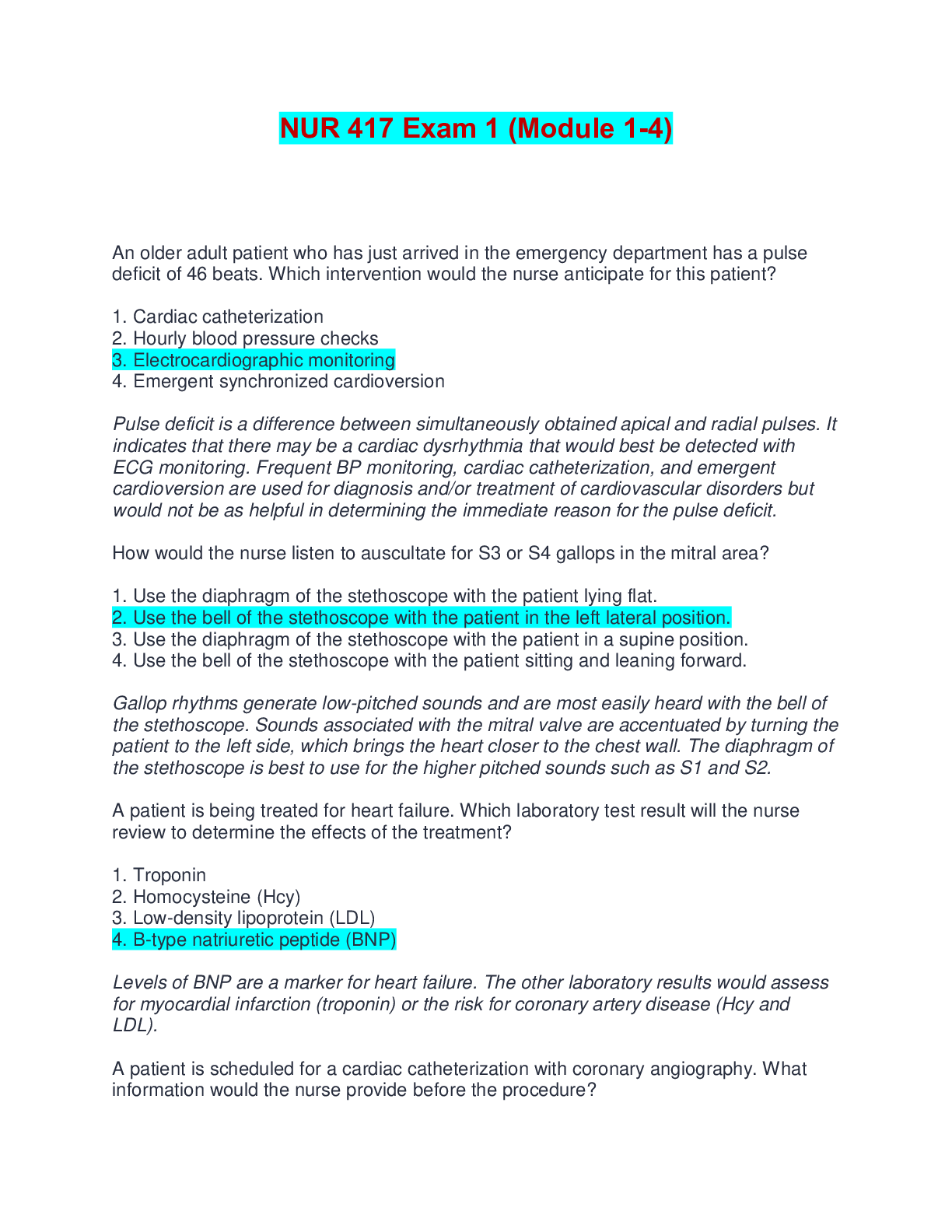
NUR 417 EXAM 1-3 BUNDLE
NUR 417 EXAM 1-3 BUNDLE
By Nurse Henny 7 months ago
$34
4
Reviews( 0 )
$15.00
Can't find what you want? Try our AI powered Search
Document information
Connected school, study & course
About the document
Uploaded On
Nov 28, 2024
Number of pages
21
Written in
Additional information
This document has been written for:
Uploaded
Nov 28, 2024
Downloads
0
Views
16

